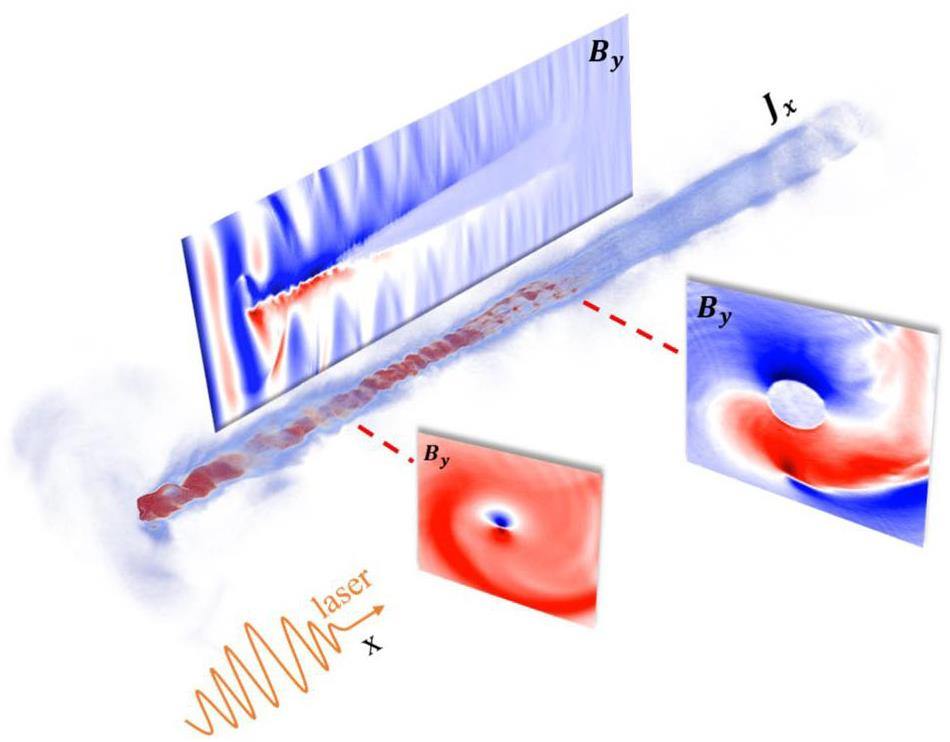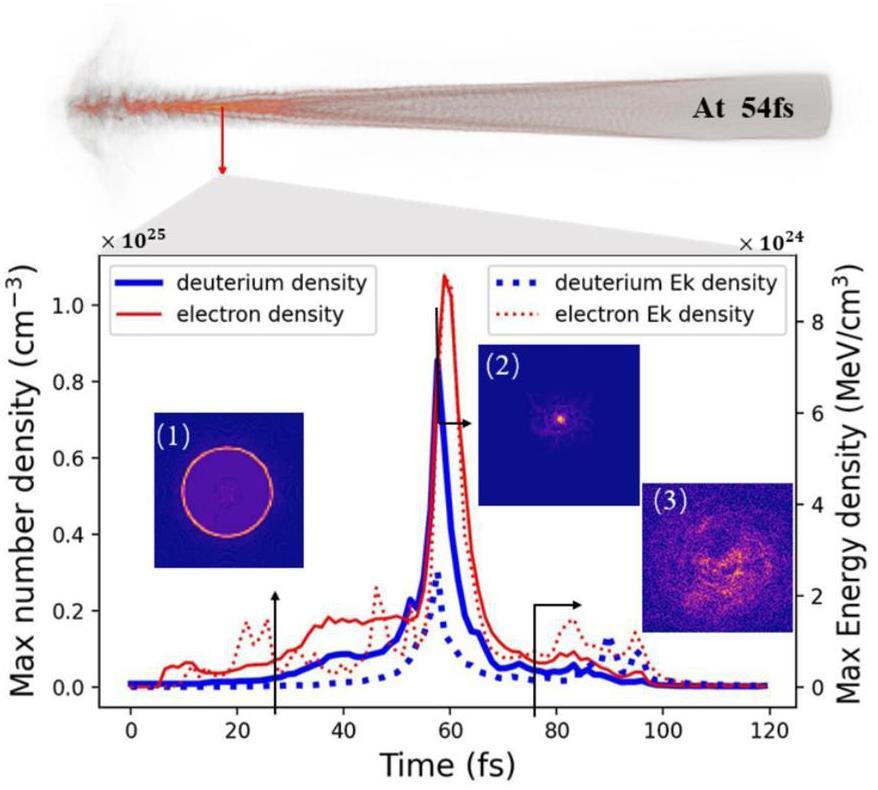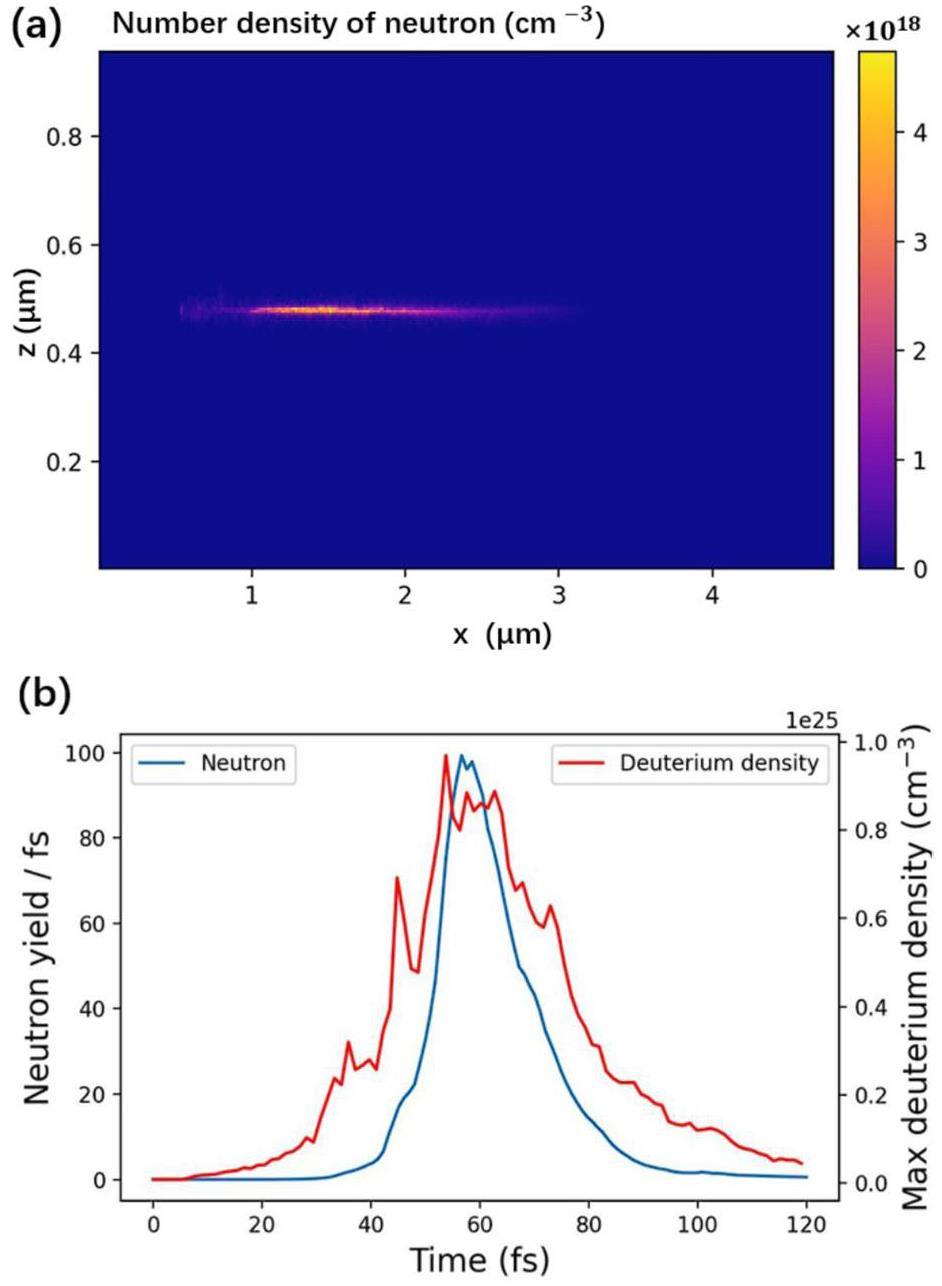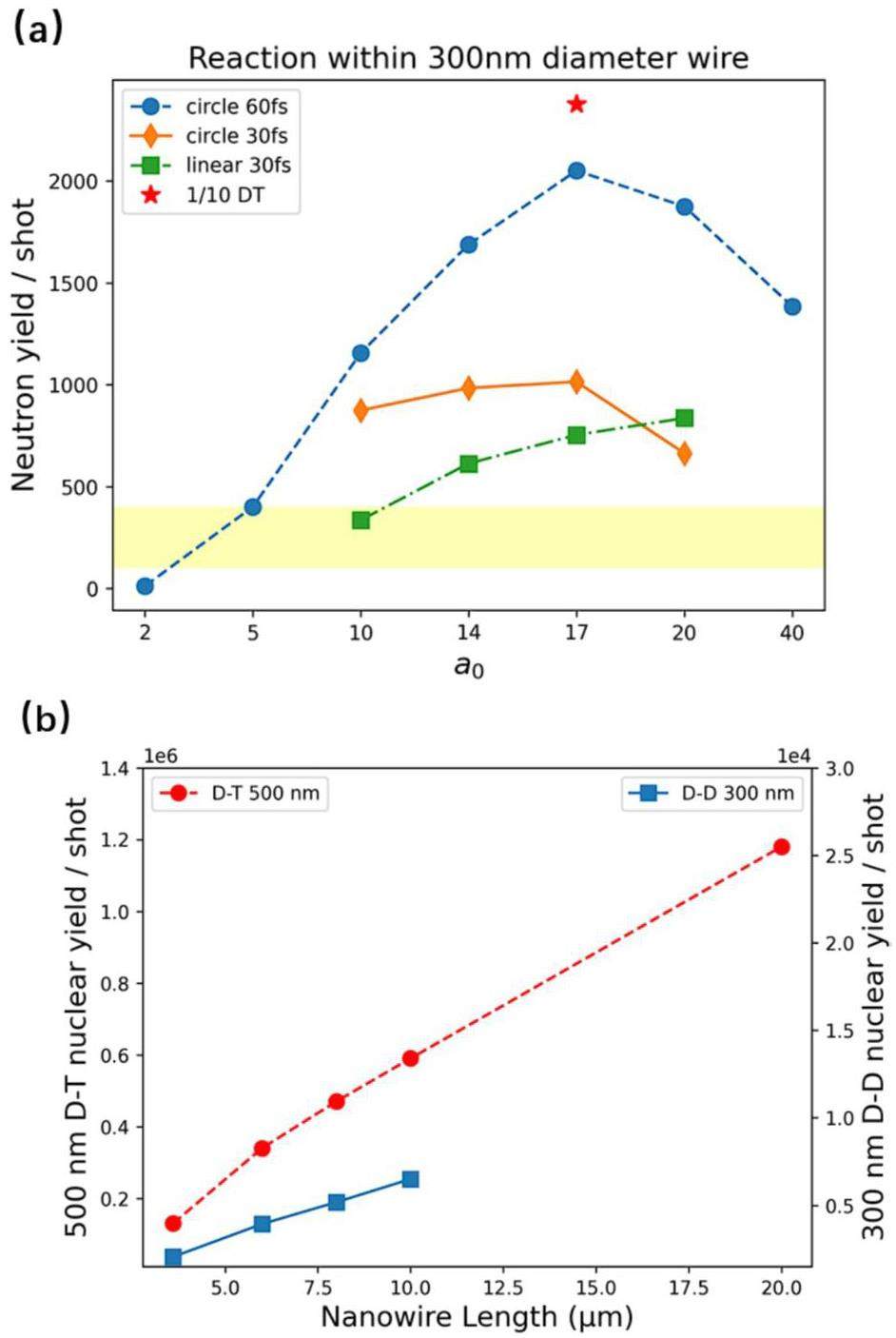Introduction
Conventional neutron sources, which include the isotope, accelerator, and reactor types, have played pivotal roles in advancing diverse scientific and technological domains such as materials science and nuclear physics [1]. Spallation neutron sources, which represent the forefront of this evolution, constitute a novel generation of high-intensity pulsed neutron sources. They have achieved neutron flux levels of approximately 1017 cm-2s-1 with short pulse widths. These attributes significantly enhance the precision of time-of-flight (TOF) measurements, which are a cornerstone of nuclear reactor design and nuclear astrophysics [2-5].
Despite these advancements, replicating high-neutron-flux conditions, which are crucial for understanding r-process nucleosynthesis [6], remains a formidable challenge. In the cosmic formation of heavy elements, neutron star mergers are the primary site of this process [7], whereas the contribution from supernovae explosions is still under debate [8]. These astrophysical events require specific conditions, including an intensive neutron flux ranging from 1022 to 1028 cm-2s-1, a range that remains elusive in laboratory settings. This gap not only hinders our comprehensive understanding of these astrophysical phenomena but also limits advancements in related fields, such as nuclear physics and astrophysics. Therefore, the development of new methodologies capable of achieving these extreme conditions in a controlled environment is crucial.
The recent development of laser-driven high-intensity neutron sources has shown the potential to fill this gap owing to their exceptional temporal resolution and ability to achieve highly localized neutron beams (spatial resolution) [9, 10]. These sources employ various methodologies, including photoneutron production [11, 12] (1021 cm-2s-1), target normal sheath acceleration (TNSA) [13, 14] (1024 cm-2s-1), and target compression via spherical shells (NIF) [15] (1030 cm-2s-1). Although these methods offer advancements, the neutron flux from the laser-driven Z-pinch has the potential to surpass the current capabilities.
Z-pinch is a phenomenon in which an axial current flowing through a plasma generates a magnetic field. The interaction between this magnetic field and the current creates a radial Lorentz force, which radially compresses the plasma to a small volume [16]. Fusion and X-ray studies have also explored the potential of Z-pinch devices [17-20]. Recent studies have focused on augmenting laser-driven Z-pinch mechanics using nanowire arrays [21-23], which present notable intrigues. Nanowire arrays efficiently absorb the energy from a femtosecond petawatt laser, resulting in a high degree of ionization and intense X-ray generation [24, 25]. In addition, ions in the array are accelerated, triggering microscale fusion reactions [26].
Therefore, we performed a particle-in-cell (PIC) simulation and found that a femtosecond petawatt laser can pinch a single nanowire to more than 120 times its original density. It is referred to as a micropinch, owing to its small spatial scale and short duration. Simulations suggest that these micropinches can facilitate nuclear fusion reactions, leading to an intense, short-lived neutron pulse with an unprecedented flux of 1027 cm-2s-1.
Simulation Setting
To investigate the neutron generation process in a Z-pinch setup, we employed full-dimensional kinetic simulations to reveal the ultrashort pinch process and the generation of neutrons using the PIC code Smilei [27]. The original nuclear reaction scheme [28, 29] was introduced in Smilei. Specifically, the cross-section for the reaction D + D→ n + 3He was integrated into the debugging version of Smilei. We improved the debugging version and corrected and checked the nuclear reaction cross-sections using a period boundary condition in a box [30]. In addition, we added the nuclear reaction D + T → n + 4He (data from [31]) to determine the potential for a higher-intensity neutron source.
In our simulation, the nanowire where Z-pinch was triggered was composed of deuterated polyethylene (CD2). The particle number density of deuterium was set as
Simulation Result
When irradiated with ultrashort high-intensity laser pulses, the atoms inside the wire undergo field ionization. The ionization process leads to a considerable potential difference on the surface of the nanowire. This potential disparity is balanced by the significant return current flowing across the nanowire's surface, maintaining quasi-neutrality. For an approximate estimation, we assumed that the electrons ionized from atoms within the nanowire were mostly distracted by the laser, corresponding to a total charge of
We performed three-dimensional (3D) simulations to illustrate the laser-induced Z-pinch process. Figure 1 shows that the electrons are pulled out by the CP laser in the void (negative current represented in blue), whereas the positive current density is the return current of the electrons flowing in the opposite direction (positive current represented in red). The return current density reached

When the return electrons are pinched radially inward by the Lorentz force, they induce an electric field owing to charge separation. Deuterium ions are then drawn and pinched symmetrically inward from the surface by this electric field, resulting in a strong radial symmetry for the kinetic energy distribution of deuterium particles within the nanowire. In the following discussion, we estimated that the temperature of deuterium in the Z-pinch was 190 keV by comparing the ratios of the nuclear reaction rates. The electrons extracted from the nanowire (which were being pushed outward) also induced an electric field, drawing the surface deuterium outward and accelerating them. If the target is an array, the collisions between them are also significant for nuclear reactions because of their higher energies. Eventually, the pinched-inward ions are compressed near the center, creating a high-density zone (Fig. 2. The corresponding maximum energy density can reach an order of 1×1024 MeV/cm3 (1×1012 J/cm3) at approximately 54 fs, which is two orders of magnitude higher than that reported in our previous work [32].

As shown in Fig. 2, compression occurred within approximately tc=10 fs, and the maximum compression diameter was approximately D=30 nm. The maximum deuterium density exceeded
Figure 3 shows the number and density of nuclear reactions (D + D → n + 3He) generated by the Z-pinch. The propagation of the produced neutrons was not considered. At this point, the energetic ions collide in the densest vicinity. Because of the extremely high particle number density, the nuclear reactions primarily occur around the axis of the nanowire, as shown in Fig. 3(a). The neutron density resulting from D-D nuclear reactions is approximately of the order of 1018 cm-3. This extremely short compression leads to a burst of reactions within femtoseconds, where the reaction rate is over 100/fs on such a small timescale, as shown in Fig. 3(b). If suitable nuclear reactions are available, the induced reaction exhibits ultrahigh peak flux and ultrashort pulse duration. From the simulations, we obtained neutrons with a narrow pulse width (30 fs) and small source surface area (

Figure 4(a) illustrates the relationship between the laser parameters (30 and 60 fs, circularly and linearly polarized, respectively) and the number of nuclear reactions generated by the Z-pinch. In addition, increasing the length efficiently enhances the number of nuclear reactions during the pinch phase. The diameter of the nanowire also affects the reaction rate. Under the same conditions, if normalized for the substance of material, the efficiency of nuclear reaction generation is the highest in the wire with a diameter of 500 nm, followed by that with a diameter of 300 nm. Both efficiencies were higher than those observed for the 200 nm and 800 nm wires.

When the D-T system was considered, the fusion yield was found to be more than 10 times greater than that of the D-D system. Comparing the yields in the same system, the equivalent temperature [37] at which the nuclear reactions occurred in this nanowire was approximately 190 keV. The neutron flux could reach 1027 cm-2s-1 in the D-T reaction system. Nanowires with a diameter of 500 nm and lengths of 6, 8, and 10 μm can generate 3.4 × 105, 4.7 × 105, and 5.9 × 105 neutrons, respectively. Notably, this growth is almost linear with the length (because of the pulse width of the laser, it must be sufficiently long). More than 106 neutrons can be generated within a single pulse if the length of the nanowire is increased to 20 μm, as shown in Fig. 4(b). Cascade reactions of D-D and D-T also occur within the system.
Conclusion
We conducted a study on the interaction between lasers and nanowires, with a particular focus on the Z-pinch effect. Notably, the deuterium density within the nanowire could exceed the initial density by more than 100 times. We analyzed the pinch density and current under different laser and nanowire parameters. The Z-pinch effect provides laser-driven nanowires with a short time scale and high spatial density environment for nuclear reactions to occur. It is thus suitable for use as a neutron source with the advantages of a small spatial scale (30 nm × 30 nm) and short pulse width (30 fs). This compression results in an extremely intense and short neutron pulse. The peak neutron flux reached 1027 cm-2s-1. High-flux nuclear reaction (neutron) sources can be utilized for research on r processes [38]. The laser can not only pinch deuterium ions but also other particles as sources in nanowires. A typical example is a proton source. With a radial flux of approximately
Research opportunities with compact accelerator-driven neutron sources
. Physics Reports 654, 1-58 (2016).China spallation neutron source: Design, r d, and outlook
. Nuclear Instruments and Methods in Physics Research Section A: Accelerators, Spectrometers, Detectors and Associated Equipment 600, 10-13 (2009). https://doi.org/10.1016/j.nima.2008.11.017The european spallation source design
. Physica Scripta 93,Measurement of the neutron-induced total cross sections of natPb from 0.3eV to 20MeV on the back-n at CSNS
. Nuclear Science and Techniques 35, 18 (2024). https://doi.org/10.1007/s41365-024-01370-zMeasurement of br(n, γ) cross sections up to stellar s-process temperatures at the CSNS back-n
. Nuclear Science and Techniques 34, 180 (2023). https://doi.org/10.1007/s41365-023-01337-6Origin of the heaviest elements: The rapid neutron-capture process
. Rev. Mod. Phys. 93,What are the astrophysical sites for the r-process and the production of heavy elements
? Progress in Particle and Nuclear Physics 66, 346-353 (2011). (Particle and Nuclear Astrophysics). https://doi.org/10.1016/j.ppnp.2011.01.032Spectroscopic identification of r-process nucleosynthesis in a double neutron-star merger
. Nature 551, 67-70 (2017). https://doi.org/10.1038/nature24298 (Particle and Nuclear Astrophysics)Laser driven neutron sources: Characteristics, applications and prospects
. Physics Procedia 60, 29-38 (2014). https://doi.org/10.1016/j.phpro.2014.11.006A route to the brightest possible neutron source
? Science 315, 1092-1095 (2007). https://doi.org/10.1126/science.1127185A tabletop, ultrashort pulse photoneutron source driven by electrons from laser wakefield acceleration
. Matter and Radiation at Extremes 2, 296-302 (2017). https://doi.org/10.1016/j.mre.2017.10.003Photonuclear physics when a multiterawatt laser pulse interacts with solid targets
. Phys. Rev. Lett. 84, 899-902 (2000). https://doi.org/10.1103/PhysRevLett.84.899Bright laser-driven neutron source based on the relativistic transparency of solids
. Phys. Rev. Lett. 110,Forward-looking insights in laser-generated ultra-intense γ-ray and neutron sources for nuclear application and science
. Nature Communications 13, 170 (2022). https://doi.org/10.1038/s41467-021-27694-7Design of inertial fusion implosions reaching the burning plasma regime
. Nature Physics 18, 251-258 (2022). https://doi.org/10.1038/s41567-021-01485-9Magnetically self-focussing streams
. Phys. Rev. 45, 890-897 (1934). https://doi.org/10.1103/PhysRev.45.890The past, present, and future of Z pinches
. Physics of Plasmas 7, 1672-1680 (2000). https://doi.org/10.1063/1.874047A review of the dense z-pinch
. Plasma Physics and Controlled Fusion 53,A review of new wire arrays with open and closed magnetic configurations at the 1.6ma zebra generator for radiative properties and opacity effects
. High Energy Density Physics 5, 115-123 (2009). https://doi.org/10.1016/j.hedp.2009.04.001The physics of fast z pinches
. Rev. Mod. Phys. 72, 167-223 (2000). https://doi.org/10.1103/RevModPhys.72.167Colloquium: Nanoplasmas generated by intense radiation
. Reviews of Modern Physics 88,Nanoscale ultradense z-pinch formation from laser-irradiated nanowire arrays
. Phys. Rev. Lett. 117,Ultra-intense femtosecond laser interactions with aligned nanostructures
. Optica 11, 437 (2024). https://doi.org/10.1364/OPTICA.510542Energy penetration into arrays of aligned nanowires irradiated with relativistic intensities: Scaling to terabar pressures
. Science Advances 3,High-efficiency water-window x-ray generation from nanowire array targets irradiated with femtosecond laser pulses
. Optics Express 29, 5427-5436 (2021).. https://doi.org/10.1364/OE.417512Micro-scale fusion in dense relativistic nanowire array plasmas
. Nature communications 9, 1077 (2018). https://doi.org/10.1038/s41467-018-03445-zSmilei: A collaborative, open-source, multi-purpose particle-in-cell code for plasma simulation
. Computer Physics Communications 222, 351-373 (2018). https://doi.org/10.1016/j.cpc.2017.09.024A pairwise nuclear fusion algorithm for weighted particle-in-cell plasma simulations
. Journal of Computational Physics 388, 439-453 (2019). https://doi.org/10.1016/j.jcp.2019.03.020A corrected method for coulomb scattering in arbitrarily weighted particle-in-cell plasma simulations
. Journal of Computational Physics 413,Simulating fusion reactions from coulomb explosions within a transport approach
. Physical Review C 106,National Nuclear Data Center
. https://www.nndc.bnl.gov/High-energy-density plasma in femtosecond-laser-irradiated nanowire-array targets for nuclear reactions
. Matter and Radiation at Extremes 7,Study of primordial deuterium abundance in big bang nucleosynthesis
. Nuclear Science and Techniques 35, 63 (2024). https://doi.org/10.1007/s41365-024-01423-3Examining the fluorine overabundance problem by conducting jinping deep underground experiment
. NUCLEAR TECHNIQUES 46,Nuclear astrophysics research based on hi-13 tandem accelerator
. NUCLEAR TECHNIQUES 46,Universal diagram for regimes of z-pinch stability
. Phys. Rev. Lett. 66, 1462-1465 (1991). https://doi.org/10.1103/PhysRevLett.66.1462Temperature measurements of fusion plasmas produced by petawatt-laser-irradiated D2-3He or CD4-3He clustering gases
. Phys. Rev. Lett. 111,Origin of the heaviest elements: The rapid neutron-capture process
. Rev. Mod. Phys. 93,rp-process nucleosynthesis at extreme temperature and density conditions
. Physics Reports 294, 167-263 (1998). https://doi.org/10.1016/S0370-1573(97)00048-3Recent progress in nuclear astrophysics research and its astrophysical implications at the china institute of atomic energy
. Nuclear Science and Techniques 35, 217 (2024). https://doi.org/10.1007/s41365-024-01590-3Novel thick-target inverse kinematics method for the astrophysical 12c+12c fusion reaction
. Nuclear Science and Techniques 35, 208 (2024). https://doi.org/10.1007/s41365-024-01573-4Yu-Gang Ma is the editor-in-chief for Nuclear Science and Techniques and was not involved in the editorial review. All authors declare that there are no competing interests.


